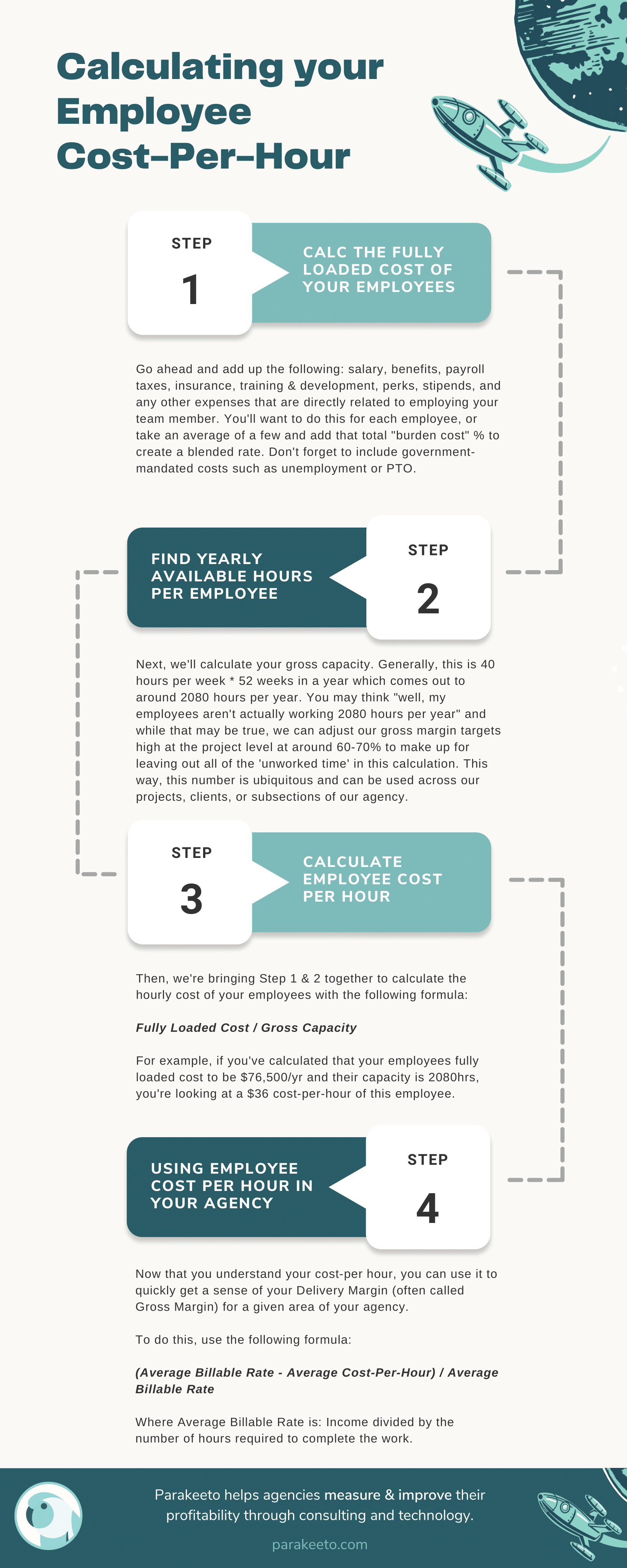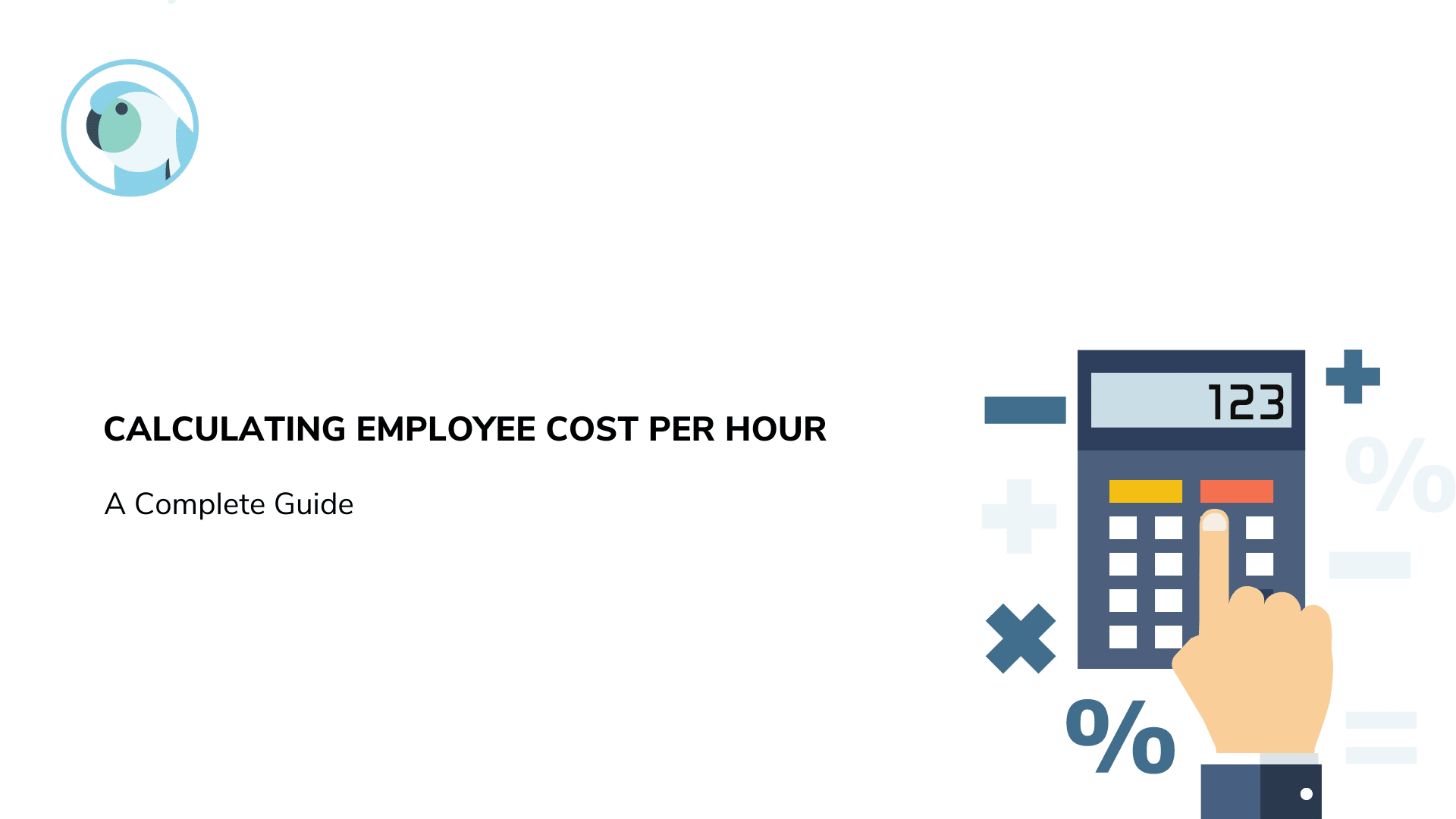Need an employee cost calculator? We created it – because there’s a lot of confusion in the agency space about what should or shouldn’t be factored in when calculating your billable employee cost-per-hour. Not to mention, it’s hard to find a solid labor rate calculator. We’re sharing our tested employee cost calculator tips in this step-by-step guide.
But first, what you came here for, a calculator to get you a salary rate per hour / pay rate per hour is below.
The ultimate question we’re all trying to answer is – how much does an employee cost per hour? Or How much does having an employee cost?
Should I include overhead in an employee cost calculation? What about worker’s compensation? State unemployment tax, social security, 401k? Should a fully loaded true cost of employee calculation be based on their gross capacity or just their billable capacity?
What about employees that are part-admin and part-billable? What about benefits and insurance? Production software? You can understand the actual cost is very different than the hourly wage.
What should and shouldn’t be included in an employee cost calculation? Tip: If you just want to try out the employee cost calculator, it’s right here. This is our 2023 employee costs calculator.
There’s a lot of mud in the water, and you’ve probably read a lot of conflicting information on the subject. So we’re helping you answer how much does an employee really cost your agency.
That’s why I’m writing this guide to give you a clear answer on the cost of an employee. I want to help you understand how to calculate this important metric in the different contexts you might encounter in your agency.
What’s in this guide:
- Fully Loaded Employee Calculator – The Method
- The Steps to Calculating Employee Cost-Per-Hour in Your Agency
- Using Employee Cost Per Hour In Your Agency
- Calculating Gross Margin
- Calculating Pass Through Expenses
- Agency Gross Income Calculation
- Calculating Direct Labor Costs
- Calculating Gross Margin on Projects or Clients
Side note: if you’re looking to calculate a selling rate per hour (or a rate per hour calculator) we’d consider that a pricing conversation, not a cost one. You can calculate your selling rate per hour here.
Why do so many people calculate employee billable cost-per-hour (salary rate per hour) the wrong way?
In my experience, most of the confusion around what to include and what not to include in employee cost calculation comes down to not being clear on how this cost-per-hour number is going to be used (and what questions it’s going to help answer).
I see this most often when questions about overhead and billable capacity come into the fold. This usually happens when someone is trying to work backward from project-costing to net-profitability.
I could go on a lengthy rant about why I don’t think trying to calculate net-margin on projects and clients is a worthwhile pursuit. (And why it’s actually more useful to understand gross margin on projects or average billable rates). But that’s a whole other post on its own.
Focus On Gross Margin First
The bottom line is that if we’re looking at the project/client level – we generally want to focus on Gross Margin first. This is because it helps us understand how efficient we are at earning revenue in our agency or service business.
It’s also a metric that allows us to benchmark things against each other both internally and externally because it removes variable costs like overhead from the equation.
You can think of Gross Margin similarity to EBITDA in this context. It’s especially useful because it levels the playing field and allows us to compare virtually any subsection of our business to another both within our agency or against the industry as well.
That’s why I recommend focusing on Gross Margin when assessing client or project level profitability and reserving net margin analysis for broader contexts in your agency.
Another important reason we want to focus on Gross Margin or Average Billable Rates is that it’s the foundation for the profitability of the entire agency.
If we can’t consistently protect gross margin on projects and earn our revenue in an efficient way, getting healthy net profit will be extremely difficult (or impossible)

I’m going to discuss how to Calculate Billable Employee Cost Per Hour for the purpose of calculating Gross Margin. We’re going to use employee cost per hour to understand what it costs us to earn revenue, and how efficiently.
Why is this important to establish before we talk about employee cost per hour? Without clarifying the question being answered it’s difficult to justify what gets factored into the employee cost calculation.
If we agree that we’re using cost-per-hour to calculate gross margin, it becomes clear that we shouldn’t be factoring in overhead of billable capacity for most employees.
What all of that said, what exactly is the formula for calculating employee cost per hour in your agency? Let’s jump in!
Fully Loaded Calculator: The Formula
In this context, Cost-Per-Hour is expressed by the following formula:
Fully Loaded Cost / Gross Capacity
This means we need to identify two things in order to Calculate Billable Employee Cost Per Hour:
- Employee Salary + Benefits (Fully Loaded Cost)
- Gross Capacity
Some notes before we begin:
- In the context of this post, Billable Employees refers to team members whose primary responsibility is doing work for paying clients.
- If you have team members who are Partially-Billable, you should allocate a portion of their salary based on the % of their time spent on billable work and adjust their capacity (in hours) accordingly.
- We define Billable Work as any time spent doing anything for clients that pay you money. (Regardless of how you charge that client, or whether or not that time actually brings in any additional revenue.)
- We’re not going to factor in overhead in these hourly costs. Since the primary objective of this exercise is to assess the Gross Profit margin at the project level. (The most common application of this metric in our experience)
Side Note: The simplest way to model capacity is often to create a “payroll grid”. This means listing all of your delivery and partial delivery employees, along with their weekly capacity and then multiplying that by the number of weeks in a given period.
Want to set benchmarks for your team and agency around utilization? You’d then add delivery/billable expectations and time off / holidays to that grid and model out your capacity and utilization targets for the team.
Example:

Want this exact payroll grid template? It’s included for free in our Agency Profitability Toolkit: Agency Profitability Toolkit:.
The Steps to Calculating Employee Cost-Per-Hour in Your Agency

I – Calculate the Fully Loaded Cost of Your Employees
The first step in getting to an accurate employee cost calculation / pay rate per hour number is looking at the loaded cost of your billable employees. Overhead costs add up beyond the flat hourly rate you pay your employees, so let’s discuss those.
This means tallying up the following things in this fully loaded cost list:
- Salary
- Benefits
- Payroll Taxes
- Insurance
- Training & Development
- Perks, Equipment & stipends
- Any other expenses that are directly related to employing this individual
For a more comprehensive list, check out this blog article by MIT
An easy way to model this is to add what we often refer to as a “Burden Cost” to an employee’s salary as a percentage. Sometimes you hear the phrase fully burdened labor rate, and that’s what we’re dealing with here.
As a rule of thumb, an additional “Burden Cost” will generally be about 15-30% of a person’s salary depending on your perks and benefits packages.
I know labor burden cost isn’t a very fun name, so you’re welcome to call labor costs whatever you want.
As an example of this labor cost:
| Annual Salary | 60,000 | |
| Payroll Taxes | 6,000 | 10% |
| Benefits | 10,000 | 16.7% |
| Insurance | 900 | 1.5% |
| Total Benefits | 16,900 | 28.2% |
| Total Cost | 76,900 |
To thoroughly calculate the cost of an employee, you’ll want to build out this kind of chart for each employee, or at least figure out what the blended average “Burden Cost” % is for your company and apply it across your team to model full loaded cost.
Be sure to also calculate any state unemployment costs you are required to pay, or paid time off according to labor laws, and other health care costs. Additional costs are usually where things can deviate. Speaking to your payroll service to get a complete understanding of how these costs vary for your team is a good way to gain clarity.
II – Find Yearly Available Hours per Employee

The next step is to figure out what each employee’s capacity is, so you can figure out their cost per hour.
This is fairly straightforward but is often done incorrectly. So we’re going to break it down.
A – Calculate Gross Capacity
The first step is to figure out each employee’s Gross Capacity. This is the total number of hours you’re essentially purchasing in bulk via your employment agreement.
Generally, this is 40 hours per week X 52 weeks in a year which comes out to around 2080 hours per year.
Generally, we think about this in terms of how many hours per week we’re paying them for in a given period of time.
We want to make sure to include any “paid time off”. This includes sick days or vacation days that we’re compensating them for, even if they’re not working for us during that time.

If you’re looking into an employee cost calculator, you might be asking yourself, “shouldn’t we be basing this cost per hour on the amount of billable time they have available in a given time period”
I can understand why you might think that, but I’ll remind you that we’re using this cost per hour number to calculate our Gross Margin.
Non-billable time like this will end up in our Gross Margin calculation in the accounting software when things get reconciled – although your accountant may want to call this contribution margin (that’s cool).
But for the purpose of modeling gross margin on a project or client level, we want to leave these costs out of our calculation. This is because billable expectations, vacation time, sick days, and other benefits can vary dramatically from one organization to another, or even one employee to another within your company.
We want to remove those factors from this calculation so we can create a ubiquitous metric that can be used across all our projects, clients, or subsections of our agency reliably and consistently.
To compensate for the fact that we’re not adjusting cost for billable capacity, we simply set our gross margin targets high at the project level (we recommend 60-70% as a target)
This bakes in the assumption that at the agency-wide level on an annual basis, we’ll lose 15-25% margin on utilization gaps and time off, and then another 20-30% on overhead ideally leaving us with a healthy net margin of 20-30% on the year-end P&L.
III – Calculate Employee Cost-Per-Hour / Calculate Pay Rate Per Hour
Now to calculate the hourly cost of each of your team members, you’ll need to bring these pieces together.
In this context, Cost-Per-Hour is expressed by the following formula:
Fully Loaded Cost / Gross Capacity
You’ll want to divide your Loaded Annual Cost by your Capacity to get to your Cost Per Hour for each employee.
Example:
| Salary | $60,000 |
| Benefits | $16,900 |
| Total Cost | $76,900 |
| Capacity | 2080 |
| Cost-Per-Hour | $36.54 |
That’s it! You now have an accurate calculation for Employee Cost-Per-Hour. You can use it to figure out your gross margin on projects, as well as calculate the cost of internal project investments in your agency! The cost of an employee should be coming into view now.
Want Done-for-You Templates to Calculate Billable Hourly Rate?
If you’re looking for an easy way to calculate this for your entire team, as well as lots of other awesome tools for improving your agency’s profitability; Check out the Agency Model Generator Template that’s included in our Free Agency Profitability Toolkit:

IV – Using Employee Cost Per Hour in Your Agency
Now that you’ve calculated employee cost per hour for each of your team members, how should you be using it in your agency?
The most common application we’ve seen has been trying to assess the profitability of projects and clients either in the scoping phase of a project or retroactively.
We wrote a pretty in-depth blog post on this topic, so if you want to go deep check that out, but here are the spark notes:
Calculating Gross Margin using Employee Cost Per Hour

The formula for Gross Margin is as follows:
Revenue – COGS = Gross Margin
Where COGS = Pass Through Expenses + Direct Labor Cost
So we need to know two things in order to calculate gross margin:
- Pass through Expenses
- Direct Labor Costs
Calculating Pass-Through Expenses
Examples of Pass-Through Expenses would be:
- Stock images
- Outsourced Work (contractors/freelancers)
- Website Templates
- Equipment rentals
- Travel costs related to production
- Any other cost that passes through you and into another vendor in order to deliver work to the client. (These may or may not be marked up – either way, it doesn’t affect this math)
Removing pass-through expenses from your gross revenue on a project produces a number we call Agency Gross Income (AGI). This is an important metric for you to be paying attention to, since it’s the number we benchmark all your spending and profitability on.
If you want to go deeper on AGI, check out this post.
Example of Agency Gross Income (AGI) calculation:
| Total Project Revenue | $100,000 |
| Camera Rentals | $10,000 |
| Freelancers | $5,000 |
| Ad Spend | $20,000 |
| AGI | $65,000 |
Calculating Direct Labor Costs
Next, we want to figure out how much it costs to earn our AGI based on the labor costs incurred on the project.
We do this simply by taking all of the time logged against the project or client and multiplying it by the Cost-Per-Hour of the employees involved.
Example:
| Employee | Cost Per Hour | Hours | Total |
| Samantha | $57.50 | 120 | $6,900 |
| James | $24.25 | 165 | $4,001.25 |
| Luis | $42.80 | 75 | $3,210 |
| Total | 360 | $14,111.25 |
Calculating Gross Margin on Projects or Clients
The last step is to subtract Labor Costs from Adjusted Gross Income (AGI) to get to our Gross Margin.
Example of Gross Margin calculation:
| Total Project Revenue | $100,000 |
| Adjusted Gross Revenue (AGI) | $65,000 |
| Labor Costs | $14,111.25 |
| Gross Margin | $50,888.75 |
| Gross Margin (%) | 50.8% |
Infographic
ㅤ

Employee Cost-Per-Hour FAQs
ㅤ
ㅤ
Cost-per-hour is determined by taking fully-loaded-cost in a time period and dividing it by the total number of hours available in that same time period. For example, $100k annual cost / 2080 annual hours = $48 cost per hour.
ㅤ
ㅤ
This is generally the total cost of salary, benefits and alternative compensation such as bonuses and commissions.
ㅤ
ㅤ
Targets for revenue per employee should be set based on your average cost per employee. Good would be 2x, great would be 3x. For example, if your average cost per employee is $75,000, a good revenue per employee would be $150,000, a great one would be $225,000.
ㅤ
ㅤ
What’s important is making sure delivery margins are at or above 50% and overhead expenses do not exceed 30% of AGI. Usually this means delivery payroll should not exceed 50% minus shared delivery costs, non delivery / administrative payroll should not exceed 30% minus overhead expenses. General benchmarks for payroll tend to be in the 65% range relative to AGI.
ㅤ
Next Steps – Determine the Real Cost of an Employee
How you calculate employee cost-per hour is an important thing to define internally so you can ensure consistency in the way things are modelled, especially when it comes to project profitability.
I encourage you to keep an up-to-date record of these figures and use this cost calculator often in your scoping and estimation process.
Load them into your time-tracking tool if it allows you to do so allowing you to more easily and quickly get a directional sense of earning efficiency on your projects.

How you calculate fully loaded employee pricing is a critical part of nailing your earning efficiency, which is the foundation of your agency’s profitability.
Understanding how well you’ve earned revenue across your clients and projects allows you to compare them to one another and identify opportunities.
One of the best ways to improve your profitability is paying attention to outliers (both positive and negative) and facilitating conversations with your team about why projects do or don’t go as planned in order to refine your processes.
If you’d like to get access to a complete system for measuring, reporting on and facilitating process improvement based on earning efficiency – download our free agency profitability toolkit which walks you through exactly how we implement this process for our consulting clients.
Take our employee cost calculator and formula for a spin.
Have questions? Leave us a comment, we’re here to help.

Marcel is an agency profitability optimization consultant, keynote speaker and the CEO of Parakeeto. He’s on a mission to help the average agency get the information they need to be more profitable. From sharing educational content and resources to creating tools at Parakeeto to make measuring the most important metrics easier – everything he does is aimed at making agency profitability more accessible.









I’m attempting to calculate costs on 3 seperate rates. Employee, employee lead and student assistant. The employee lead is at $25/hour, the employee is $15/hour and the student is $10/hour. The employee and leads are working 30 hours/week (1,560/year), students are at 20 hours/week (1,040/year). I don’t have an office without the account but imagine I will need one, a small one maybe $2,500 a month and then worker’s compensation, general liability and vehicle insurance. Profit margin and administrative costs? I am seeking a liason type position to oversee the client. Thanks so much
Hey Stuart, I’m not sure I fully understand the question but your billable cost-per-hour will be whatever you’re paying your staff + any benefits, payroll taxes, etc. Directly related to their compensation.
Your Gross Profit margin will be the revenue you receive from the client, minus the cost of your team’s time and any materials or pass-through expenses directly related to the project.
Your Net Profit margin will be your gross margin minus all of your overhead and admin costs – which in this case would be your office, liability and vehicle insurance, etc.
Hope that’s helpful!
Why did you choose to use the gross capacity and not net capacity? Using 2080 seems to give a lower cost price than you are actually paying because in reality, salary stays the same while you are actually being able to sell/charge/bill fewer hours to the client because nobody works 2080 hours a year taking into account sick days and holiday.
Wouldn’t you say it gives a more accurate Cost per hour to calculate Salary / Total Billable Capacity [where total billable capacity = (2080 – Total time off) * billable target %].
Looking forward to hearing your thoughts.
Hey Ritchie, thanks for a great question.
As I mentioned earlier in the post, we’re calculating employee cost per hour in this case for the purpose of measuring Gross Margin on individual projects, so that we can benchmark them against each other and the industry. That’s why in this case, we’re looking at cost per hour based on gross capacity. It keeps things cleaner and simpler versus mixing in time-off and holidays since that will fluctuate within teams, across agencies and across different geographies based on the laws and cultures (making it difficult to truly benchmark what an efficient gross margin target is for a project-project basis) and it can add additional complexities to the accounting workflow if we’re trying to account for all those moving pieces.
Where we should be factoring those things in of course is when we look at longer time horizons, and on a departmental or agency-wide level. You can usually expect your gross margin for your production department to be 15-30% lower than on a per-project basis due to gaps in utilization, time-off, sick days, office parties, etc. as you mentioned.
If you want to try and work down to a cost per hour that factors these things in on a per-project basis, there’s nothing wrong with that per-se. You may just be making things more complicated for yourself down the line as your reporting and data gets more complex.
I hope that helps create some clarity. Thanks for the great question!
Using cost-per-hour to calculate gross margin, it becomes clear that we shouldn’t be factoring in overhead of billable capacity for most employees.
Cost calculator is a simple, ready-to-use online calculator, designed to help you compute your total cost amount. You can easly calculate cost amount using cost calculaor.
Hi,
Marcel Petitpas, Thanks for helping us making helpful content on accurately calculate your agencys billable employee cost per hour. I would like to give great value your content as i will be sharing this meaningful information with my friends as well.
Hello,
I have a question about the Annual Delivery capacity once the Billable capacity is below 40 hr/week. Once I reduce the billable capacity it seems that the hours are being reduced by an additional 5 hours for every 1 hour.
An example works 40hrs per week, 40hrs billable days per week, 25 days off = 1880hrs Annual Delivery Capacity. If the employee is only billable 32 hours per 40 hour week their adjusted Annual Delivery Capacity should be 1504 (32/40 = 80%) then (80% x 1880) = 1504 the calculator is deducting an additional 40 hours = 1464. Am I missing a factor?
Hey Gee, thank you for surfacing this! There was a bug in one of the calculations to your point. This has been addressed and should be reflected in the calculations now.
Hi,
This cost estimation blog post is a gem! The tips provided here are not only applicable to professionals in the field but also to anyone who wants to manage their personal finances more effectively. The language used is accessible, and the examples make the concepts easy to grasp. I’m grateful for the valuable knowledge shared in this post, and I’ll definitely be implementing these tips in my future projects.
Thank you!
This is an awesome post and so helpful. Thank you. I do have a question. How do you account for raises given to your billable employees in the calculations? Should I average their pay rates together and us this amount? Any help will be greatly appreciated. Thank you.
Hi Liz!
I’m so glad you found this post helpful 🙂
And thank you for your question, it’s a great one!
The answer to your question depends on the purpose of the ACPH measurement in question, and in particular, what time horizon you’re trying to measure it over.
If the purpose is to set rates going forward, for example, than you always want to base the ACPH on the latest compensation model for a given employee.
For example, let’s say they made $100,000 in total compensation (payroll + benefits) and are now getting a raise to $110,000, and your objective is to understand how to measure their cost on projects going forward, or establish an updated target Average Billable Rate, you would use the $110,000 compensation that is effective now and going forward.
However, if you are trying to look backwards and determine an average ACPH for a historical time period, perhaps for trying to get an approximate sense of their ACPH on historical projects, you would then have to prorate their total compensation for that time period. This is a value you should be able to easily pull out of a payroll system or your accounting system, but doing the math isn’t too difficult either.
For example, if we were trying to figure out a blended/average cost per hour for an employee over the last 12 months, and this person was at $100,000 for the first 10 months and $110,000 for the last two, their total compensation would be $83,333 + $18,333 = $101,666 so we would base their ACPH on that compensation number.
There aren’t many instances where it’s going to be necessary to look back and try to determine an ACPH in a blended way. Most of the use cases for ACPH will simply be based on the latest compensation model for a given person going forward.
It’s important to note that ACPH doesn’t have to be based on annualized numbers either, you can determine an ACPH using a compensation and capacity value for any increment of time, whether that be a week, a month, a quarter, a year, or anything in between.
Hope that helps!
Using cost-per-hour to calculate gross margin, it becomes clear that we shouldn’t be factoring in overhead of billable capacity for most employees.
Thanks for the comment! That’s exactly right – it’s not to say we shouldn’t consider the cost of overhead or non-billable time. It’s just a question of factoring that into the Gross Margin target using a more stable heuristic. Doing this makes the measurement of Gross Margin more horizontally consistent – which means we can compare it to past time period and past projects more accurately, and makes it simpler and less expensive to measure.
Marcel Petitpas, thank you for creating such valuable content on accurately calculating your agency’s billable employee cost per hour. Your insights are incredibly helpful, and I’m excited to share this information with my friends as well.
Appreciating Content! Marcel Petitpas, you are sharing very informative post that is very helpful for me. I actually wanted to know that How to Calculate Your Billable Employee Cost-Per-Hour. Looking forward for your next post.
Your content is very helpful. I would like to share with others